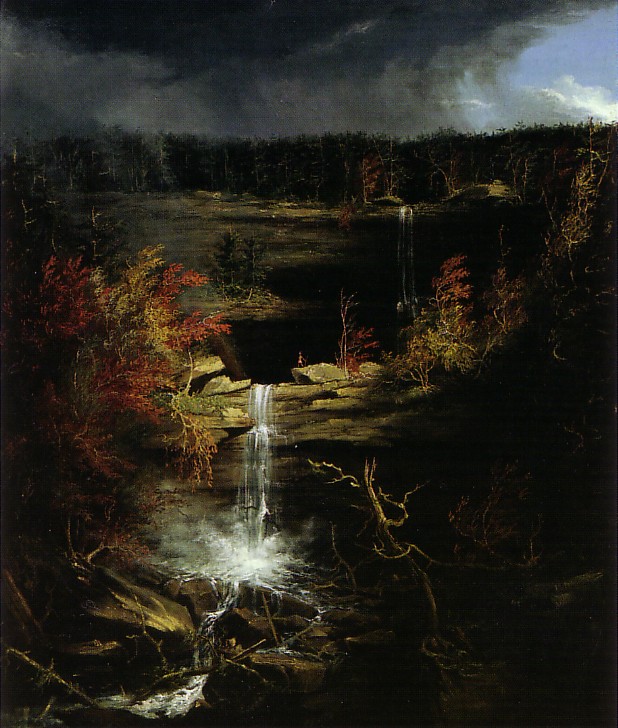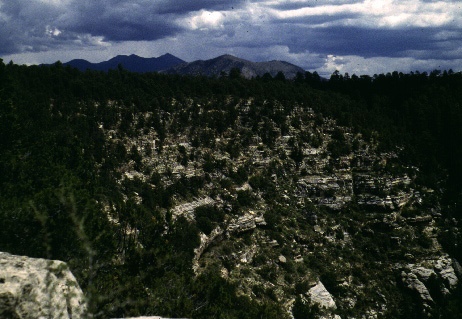| Walking towards Walden: A
Pilgrimage in Search of Place.
|
|
 |
John Hansen Mitchell,
|
| A glacial lake in Maine. | |
(No index) |
|
| In telling the
story of a hike from Prospect Hill in
Westford to Author’s Ridge in
Concord, the author weaves a story of three trekkers (himself & two
friends) and their journey South to Florida and west to the Hopi Mesas.
Undertaken on Columbus Day!
|
|
..
Pages __________ Text _________________________________________________ comments
Page 92 “Nomads
of course, move with direction. Unlike the wandering lost Americans, wheeling
along at sixty miles per hour just for the sake of the trip, nomadic people
know exactly where they are going and exactly why they are in a certain place
at a certain time.”
Page 93 …there
is no people with a more highly developed sense of place than the nomadic
tribes; they read water table levels by the quality of the grass, they know
every stone along their route, they navigate by the pattern of clouds or by the
lay of hills, or by water courses dried for a hundred years.
Page 94 “We
are a lost people by contrast. We do not know our place.”
Page 95 “But
here in America, mobility has worked its way into the culture.”
Page 97 Mt.
Baboquivari near Tucson is the
spiritual center for the Thono O’odham peoples of the
Sonoran desert southwest.
San Francisco Mountains of the southwest ancestral home of the Hopi, Kachinas.
John Hansen
Mitchell, Walking towards Walden: A
Pilgrimage in Search of Place,
Native Places
Page 98 Native
American dancers in the SW dance and in the dancing they “dance out the
features of the landscape, mountains, arroyos, cactus and coyote.
“they were
recreating landscape.”
Vincent Scully,
architectural historian says that:
1
Greeks,
temple, the site and the god cannot be separated
2
Native
American, dance is at once a reflection and a creation of the landscape in which it
occurs.
Page 99 Dreamtime
for Australian Aboriginals is the same, they sing the landscape into existence,
and the song is the map of the land in which they find themselves. “They
created the world by singing it into existence.”
Page 100 “Walking
there towards Walden Pond, through a landscape layered with human histories, it
seems to me that the one commonality among these disparate events and artifacts
has something to do with the human relationship to place, to querencia and the Hopi idea of túwanasaapi.”
Page 123 Chimayo (Tsi maio)

Sanctuary of Tsimayo, New Mexico; an Anasazi healing place.
Book notes:
John Hansen Mitchell,
Pages ____________ Text comments
Page 124 “Chinese”
land is invested with chi feng shui, or “spirit
power.”
“Wampanaogs call
it manit” “It would manifest itself
in animals, in landscape, or even in the behavior of people.”
Page 135 “the
third place” Sociologist
Ray Oldenburg argues
that in addition to:
1 Home; the nesting place
2 Workplace
3 A place where you gather daily for
respite; watering hole, well, (pub, café)
“Once the heart
and soul of a community’s social life.”
“the defining
element in a town or city, they were at once the forge of the character of a
given region or place and also its ultimate expression, the focal point in
which regional identity would be exhibited.”
Page 144 “This
perception of territory, of a base of some sort, seems to be a deeply rooted
biological concept.
“Querencia” that
area occupied by the animal in a bullring that he will defend against the
encroaching matador.
Q is defined variously as a haunt of wild
beasts, a home or nest, a favorite and frequent place of refuge, a preferred
place and also a love of home.”
Page 145 “the
term connotes a deep sense of well-being that is associated with a given spot
on earth, a sort of personal identity with a place that arises from the fact
that the world there is known to you, that its history is your history, that
the fruits and flowers, the scents of the earth, the days and nights, the
seasonal changes, are a part of your personal past.”
“The Hopi word Túwanasaapi conveys the same idea.
Thought it means literally the center of the Universe, it also describes that
place that is right for you.”
Page 146 “That’s
what everything is all about Nanny, Territory, Territory!” exclaimed Elliot
Howard in 1920—author of Territory in Bird Life.
Pages _________ Text comments
Page 175 “1521
voyage of Ponce de Leon”
Cayo Hueso, or
Bone Key mistakenly
called Key West by the English
“Key West
evolved into one of the most successful communities in the east.”
Page 176 “Key
West (up until 1960s) was one of the few places in Florida –for that
matter in the US—that had a clear identity. Everyone showed up there at
one point or another.
“KW…where the
continent ends.”

“Camped as close
to Florida Bay as we could get. In the middle of the night, in the over arching
stillness, I heard Dolphins breaching.”
Next day
“The
grass was hot and smelled of salt, wood storks wheeled in gyres above the
islands of hardwoods, and lines of ibis drifted over the horizon.
Page 181. Henry
David Thoreau’s, Faith in a Seed. Published in 1993!
“The ideas
describe the process of plant succession and anticipate the current theories of
ecology by a hundred years.”
Page 182 “Thoreau
integrated Darwin’s theory on natural selection with his observations and
applied it to plants to come up with what is now recognized as an accurate
description of the way in which plants distribute themselves in a given
habitat.”
Page 182 “understand
the effect that geography can have on creativity.”

183-184 For
example, Parterre, Dante and Dumas in the Provence.
The gypsies and
the Camargue: Sainte Marie sur le mare
187 Vienna Woods
188 Gui Lin, China.
Tuscany, Italy
189 Hudson Valley, Cooper,
Bryant & Irving, Cole Diederich
Knickerbocker the invented historian of upstate (by Washington Irving)
Catskills & Berkshires form the western & eastern mountain ranges of the Hudson gräben
Book notes:
John Hansen
Mitchell, Walking towards Walden: A
Pilgrimage in Search of Place.
(Washington Irving may be the earliest
prototypically American writer. He is clearly grounded in place, landscape and
travel. Born in 4/3/1783 and died on 11/28/ 1859, he wrote of the Hudson
Valley, lived in England, traveled to Spain, returned to the states and went
west, had a fondness for Indians and wrote biographies of Columbus and George
Washington. He died in Sunnyside on the banks of the Hudson, a fierce democrat;
he was John Tyler’s (Whig) Minister to Spain from 1842-46.)

The Hudson River Valley
Pages _____________ Text comments
Page 191 “For
the pilgrim, the very journey may be part of the ritual. The pilgrim comes to
be uplifted, and the Concord visitors of the late nineteenth century were there
to be enlightened, not entertained.”
“There was no
landscape to draw them;…. no scenic features sufficiently marked to arrest the
tourist.”
“…they were
attracted by the concept of a native
place.
“going home to
Concord.”
194 quotes Thomas Cole, “Lecture on American Scenery,”
1841
“In this age,
when a meager utilitarianism seems ready to absorb every feeling and sentiment,
and what is called improvement, in its march, makes us fear that the bright and
tender flowers of the imagination will be crushed beneath its iron tramp, it
would be well to cultivate the oasis that yet remains to us.”
199-200
Estabrook
Wood – deserted then and forested now.

The Woodstock river, in southern Vermont.
201 “Thoreau said in
his journals that every town
202
should
have a park or forest of five hundred or a thousand acres in common possession
forever, preserved for recreation or instruction, where never so much as a
stick of firewood should be cut. The Estabrook Woods fits this description
perfectly. In fact, Henry specifically cites the Estabrook Country, as he
called it, as a perfect spot for such an endeavor.”
204 “the nation was becoming industrialized,
and it had two epicenters. One of these Concord, was literary, and the other,
the Hudson River Valley, was pictorial.”
204-207, Hudson
River School, luminists and the Rocky Mountain School of painters.
206 “the American public began to develop an embryonic environmental consciousness.”
Thanks to painters and Transcendentalists
foci on landscape.

Thomas Cole, Kaaterskill Falls.
207 “There is nothing
unusual about seeing landscape as metaphor and then creating a work of visual
art to represent the idea. The Greek temples were a manifestation of the god in
a given locale. Chinese Taoist painters depicted in their landscapes the
interplay of elemental forces of creation: vast mountain slopes, a gnarled
tree, a small hut, a smaller human figure, subsumed by receding ranges of
mountains, waterfalls, twisted pines, all leading up into a vast, amorphous, empty
sky, the symbolic nothingness of the Tao.”
Henry David Thoreau, Faith in a Seed
–--------–---––––, Civil Disobedience
Thoreau's complete works on line.
Source:
Walking towards Walden: A
Pilgrimage in Search of Place, (Reading, Mass.: Addison-Wesley, 1995.)


